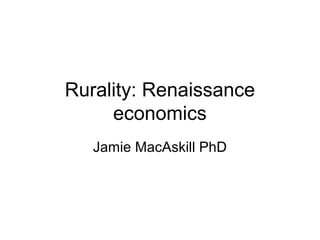Rurality
- 1. Rurality: Renaissance economics Jamie MacAskill PhD
- 2. Bridging the route to market Concept of Creative destruction Joseph Schumpeter 1942 Entrepreneurial outcomes E.F. Schumacher âSmall is beautifulâ 1973, concepts of appropriate technologies & sustainable development Destructive innovation C.M.Christensen âInnovatorâs Dilemmaâ 1997 From partnership to profit Policy into reality
- 3. To sustain or disrupt âĒ Sustainable approaches âĒ Improving existing or established products âĒ Discontinuous, radical or incremental âĒ Enormous potential for âdriftâ âĒ Builds on existing paradigm âĒ Disruptive approaches âĒ Very different value proposition âĒ Targeting different market segments âĒ Long-term benefits may be obscured by short âterm performance âĒ Enormous capacity to move minor markets into mainstream
- 4. Cornerstone âĒ Asking the customer what they want âĒ Corporate inertia even in well run businesses leads to loss of effectiveness â Managers donât make decisions Stakeholders do âĒ Incremental change to maintain growth & profit â Policy drift leads to divergence from original benefits âĒ Retreat from small markets in search of big profit âĒ Customers are fickle and technologies can outstrip obvious need and hence fail âĒ Governments seeking re-election give the biggest lobby what they want but this leads to unintended consequences âĒ Rural Economies âĒ Farmers keep farming âĒ CAP reform is actually policy drift âĒ FDI becomes a quick win âĒ Become progressively deskilled âĒ Social capital is undervalued âĒ Youth migrate to urban environments âĒ Increasing social welfare issue âĒ Why should rural economies be any different from urban economies but with a different set of âquality of lifeâ measures
- 5. CAP Reform âĒ Today CAP has built a dependency culture rather than an empowered society âĒ Disruptive approach might ask âĒ Do traditional economic models work âĒ Do direct subsidies help transformation âĒ Do current perspectives âstallâ rural development âĒ Does current âframingâ of the issues maintain or worse promote Policy drift. â What is the countryside for â Who is the countryside for â What era is being preserved âĒ Are we asking the right question
- 6. Governments dilemma âĒ World already produces more than enough food to support global growth â We still have for famine and crisis âĒ Policy is a blunt instrument â Should build infrastructure for success â Not try to solve individual problem âĒ Society, that is individuals, must assume responsibility â Otherwise you remove responsibility â Build dependency
- 7. Convergence
- 8. Convergence âĒ CAP remains at 41% of EU budget âĒ CAP over the last 30 years spend on direct subsidies âĒ 1980-1993 25-30% CAP âĒ 1992-2006 25-30% CAP âĒ 2005-2009 25-30% CAP âĒ Despite large increases in budget and shifts to different âPillarsâ âĒ Funding farmers to farm however efficiently âĒ Preserving the countryside âĒ Is this sufficient to transform the sustainable use of natural resources and promote food security
- 9. Comparative Advantage Source Eurostat 2012
- 10. Renaissance Economics âĒ Disruptive approach âĒ Get rid of subsidy âjunkiesâ âĒ Data demonstrates opportunity for local comparative advantage âĒ Traditional economic approaches maintain status quo and keep rural economies essentially agricultural or old age communities âĒ We should operate a two tier economic strategy â National states support infrastructure â Local competitive advantage delivering real value âĒ Require to produce viable, vital & vibrant rural economies: sustainable and growing âĒ Direct subsidies effectively block new entrant or indeed distort market opportunities
- 11. Unconventional times âĒ Renaissance Economics â Resets Policy back from the divergence of Policy âDriftâ affects â New rural renaissance economic model âĒ Re-engages fully with market demand more Hayak than Keynes âĒ Reduce to zero direct subsidies âĒ Re-addresses the true value of food chain âĒ Remove inefficient farming practices âĒ Re-shape the vision for what rural economies should offer â Net inward migration â Job prospects for youth â Entrepreneurial opportunities â Job creation through quality of life improvements â Harnessing local comparative advantages â Intervention is at infrastructural level & planning legislation â Government âleansâ down and local âentrepreneursâ re-invigorate social capital availability â Builds real re-assessment of value chains and supply chains at local levels
- 12. Thank you Dr Jamie MacAskill www.bite.ac.uk Tel: +44 (0)2085523071 email: jmacaskill@bite.ac.uk âSome people see things as they are and say why. I dream things that never were and say why not?â George Bernard Shaw www.academy-zone.com
- 13. Principles of Disruptive Innovation* âĒ Companies depend on customers and investors for resources âĒ Managers do not control investment decisions, Shareholders and Customers do âĒ Small markets donât solve growth needs of large companies âĒ Hence big companies tend to innovate through acquisition âĒ Markets that donât exist canât be analyzed âĒ Data is historical and so can historical data forecast the future or is it a sustaining and incremental route bound to fail âĒ Use discovery based planning âĒ An organizationâs capabilities define its disabilities âĒ Strengths correlate with weaknesses and so companies may find it difficult to engage with disruptive innovation and lean start-ups âĒ Technology supply may not equal market demand âĒ Companies constantly seek to move up market leaving behind poorer profitable markets for more high value : high profit markets âĒ Inevitably competitors invade these markets and disrupt the market âĒ Sometimes investing in smaller less profitable markets is correct to avoid entrants stealing your market space *Innovatorâs Dilemma (1997) Clayton Christensen
- 14. Disruptive Innovation *Innovatorâs Dilemma (1997) Clayton Christensen
Editor's Notes
- #3: Schumpeter : Theory of economic innovation and progress Concept of Creative destruction Joseph Schumpeter, particularly in his book Capitalism, Socialism and Democracy , first published in 1942. Applying similar approaches to rural economies on the basis that they represent fractured markets where agriculture or rural economies are failing where entrepreneurs enter the rural economy to replace or develop agriculture this will form a force for log term economic renewal that can develop: Vital, Vibrant, Viable rural economies and societies














